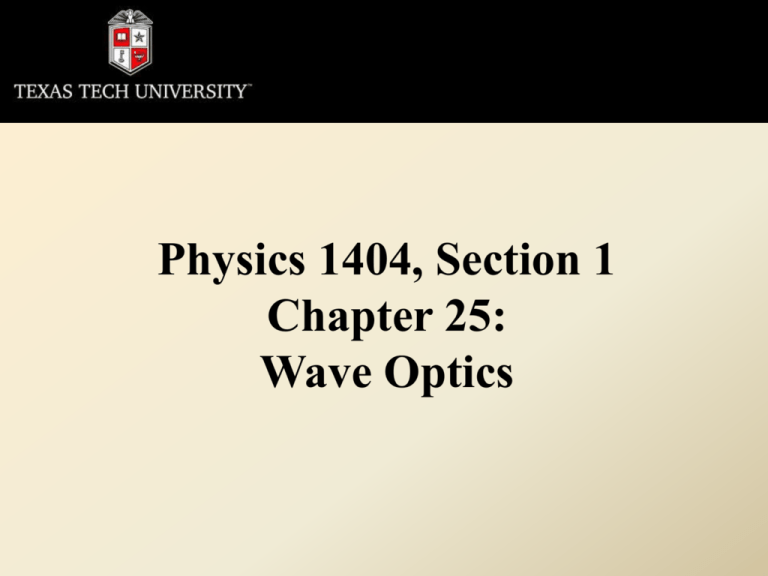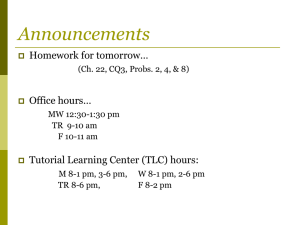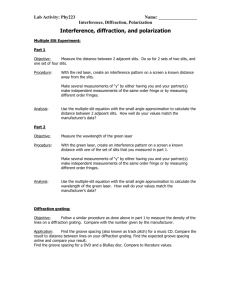Power Point Slides for Wave Optics
advertisement

Physics 1404, Section 1 Chapter 25: Wave Optics Contents • • • • • • • • Coherence and Conditions for Interference The Michelson Interferometer Thin-Film Interference Light through a Single Slit: Qualitative Behavior Double-Slit Interference: Young’s Experiment of Light from a Single Slit Diffraction Gratings Optical Resolution and the Rayleigh Criterion Why Is the Sky Blue? Coherence and Conditions for Interference Wave Optics • The field of wave optics studies the properties of light that depend on its wave nature • Originally light was thought to be a particle and that model successfully explained the phenomena discussed in geometric optics • Maxwell’s theory of electromagnetism convinced physicists that light was a wave • When discussing image characteristics over distances much greater than the wavelength, geometric optics is extremely accurate • When dealing with sizes comparable to or smaller than the wavelength, wave optics is required Interference • One property unique to waves is interference • Interference of sound waves can be produced by two speakers 1. Constructive Interference • When the waves are in phase, their maxima occur at the same time at a given point in space • The total wave displacement at the listener’s location is the sum of the displacements of the two individual waves • If two waves are in phase, the sum of their displacements is large 2. Destructive Interference • The maximum of one wave can coincide with the minimum of the other wave • These waves are out of phase • The interference is destructive when the waves are out of phase • If the waves are 180° out of phase, the sum of the displacements of the two waves is zero General conditions for interference. • Two waves can interfere if all the following conditions are met. 1. Two or more interfering waves travel through different regions of space over at least part of their propagation from source to destination. 2. The waves are brought together at a common point. 3. The waves must have the same frequency and must also have a fixed phase relationship. Thus, over a given distance or time interval the phase difference between the waves remains constant. Such waves are called coherent. The Michelson Interferometer • The Michelson interferometer is based on the interference of reflected waves • Two reflecting mirrors are mounted at right angles • A third mirror is partially reflecting – Called a beam splitter • The incident light hits the beam splitter and is divided into two waves • The waves reflect from the mirrors at the top and right and recombine at the beam splitter • After being reflected again from the beam splitter, portions of the waves combine at the detector • The only difference between the two waves is that they travel different distances between their respective mirrors and the beam splitter • The path length difference is ΔL = 2L2 – 2L1 • The path length difference is related to the wavelength of the light DL N= l – If N is an integer, the two waves are in phase and produce constructive interference – If N is a half-integer the waves will produce destructive interference • For constructive interference, ΔL = m λ • For destructive interference, ΔL = (m + ½) λ – m is an integer in both cases • If the interference is constructive, the light intensity at the detector is large – Called a bright fringe • If the interference is destructive, the light intensity at the detector is zero – Called a dark fringe Example • A helium–neon (He–Ne) laser emits light with a wavelength of approximately λHe–Ne =633 nm. Suppose this light source is used in a Michelson interferometer and one of the mirrors is moved a distance d such that exactly N = 1,000,000 bright fringes are counted, calculate d. Solution: When the mirror moves a distance d, the distance traveled by the light changes by 2d because the light travels back and forth between the beam splitter and the mirror. ΔL=2L2 – 2L1=2(L2 – L1)=2d d = 0.5×1000000×633×10-9m=0.317m Thin-Film Interference • Assume a thin soap film rests on a flat glass surface • The upper surface of the soap film is similar to the beam splitter in the interferometer • It reflects part of the incoming light and allows the rest to be transmitted into the soap layer after refraction at the air-soap interface • The transmitted ray is partially reflected at the bottom surface • The two outgoing rays meet the conditions for interference – They travel through different regions – They recombine when they leave the film – They are coherent because they originated from the same source and initial ray • From the speed of the wave inside the film lfilm ƒfilm c = nfilm • The wavelength changes as the light wave travels from a vacuum into the film 2d N= • The number of extra wavelengths is lfilm Thin-Film Interference, Case 1 • Waves reflected by a thin film undergo a phase change • The number of extra cycles traveled by the ray inside the film completely determines the nature of the interference • If the number of extra cycles, N, is an integer, there is constructive interference • If the number of extra cycles is a half-integer, there is destructive interference 2d = ml constructive interference nfilm 1ö æ m + l ç ÷ 2ø è 2d = destructive interference nfilm Only if: nair < nfilm < n(substance below the film) Thin-Film Interference, Case 2 • Assume the soap bubble is surrounded by air • There is a phase change at the top of the bubble • There is no phase change at the bottom of the bubble • Since only one wave undergoes a phase change, the interference conditions are 1ö æ m + l ç ÷ 2ø 2d = è constructive interference nfilm 2d = ml destructive interference nfilm Example 25 .3 Color and Thickness of a Soap Film • Consider a bubble formed from a thin, soapy film that looks blue when viewed at normal incidence. Estimate the thickness of the film. Assume its index of refraction is nfilm=1.35 and blue light has a wavelength λblue=400 nm. Also assume the film is so thin that thinner films are not able to give constructive interference. Solution: The interference here is destructive and we consider m=0: Light through a Single Slit: Qualitative Behavior • Light passes through a slit or opening and then illuminates a screen • As the width of the slit becomes closer to the wavelength of the light, the intensity pattern on the screen and additional maxima become noticeable Single-Slit Diffraction • Water wave example of single-slit diffraction – All types of waves undergo single-slit diffraction • Diffraction is the bending or spreading of a wave when it passes through an opening • It is useful to draw the wave fronts and rays for the incident and diffracting waves • Huygen’s Principle can be stated as all points on a wave front can be thought of as new sources of spherical waves Double-Slit Interference: Young’s Experiment of Light from a Single Slit Double-Slit Interference • Light passes through two very narrow slits • When the two slits are both very narrow, each slit acts as a simple point source of new waves • The outgoing waves from each slit are like simple spherical waves • The double slit experiment showed conclusively that light is a wave • Experiment was first carried out by Thomas Young around 1800 Young’s Double-Slit Experiment • Light is incident onto two slits and after passing through them strikes a screen • The light intensity on the screen shows an interference pattern • If the slits are separated by a distance d, then the difference in length between the paths of the two rays is ΔL = d sinθ • For constructive interference, d sinθ = m λ – m = 0, ±1, ±2, … – Will observe a bright fringe – The light intensity will be large – The waves will be in phase when they strike the screen • For destructive interference, d sinθ = (m + ½) λ – m = 0, ±1, ±2, … – Will observe a dark fringe – The light intensity will be zero – The waves will not be in phase when they strike the screen Double-Slit Intensity Pattern • The angle θ varies as you move along the screen • Each bright fringe corresponds to a different value of m • Negative values of m indicate that the path to those points on the screen from the lower slit is shorter than the path from the upper slit l • For m = 1, sinq = d is the distance between the slits W is the distance between the slits and the screen h is the distance between the adjacent bright fringes d • Since the angle is very small, sin θ ~ θ and θ ~ λ/d • Between m = 0 and m = 1, h = W tanθ Approximations • For small angles, tan θ ~ θ and sin θ ~ θ • Using the approximations, h = W θ = W λ / d Interference with Monochromatic Light • Light with a single frequency is called monochromatic (one color) • Light sources with a variety of wavelengths are generally not useful for double-slit interference experiments – The bright and dark fringes may overlap or the total pattern may be a “washed out” sum of bright and dark regions – No bright or dark fringes will be visible Example 25 .5 Measuring the Wavelength of Light • Young’s double-slit experiment shows that light is indeed a wave and also gives a way to measure the wavelength. Suppose the double-slit experiment in Figure 25.20 is carried out with a slit spacing d=0.40 mm and the screen at a distance W=1.5 m. If the bright fringes nearest the center of the screen are separated by a distance h=1.5 mm, what is the wavelength of the light? Solution: Single-Slit Diffraction: Interference • Slits may be narrow enough to exhibit diffraction but not so narrow that they can be treated as a single point source of waves • Assume the single slit has a width, w • Light is diffracted as it passes through the slit and then propagates to the screen • The key to the calculation of where the fringes occur is Huygen’s principle • All points across the slit act as wave sources • These different waves interfere at the screen • For analysis, divide the slit into two parts • If one point in each part of the slit satisfies the conditions for destructive interference, the waves from all similar sets of points will also interfere destructively • Destructive interference will produce a dark fringe Single-Slit Analysis: Dark Fringers • Conditions for destructive interference are w sin θ = ±m λ (m = 1, 2, 3, … ) – The negative sign will correspond to a fringe below the center of the screen Single-Slit Analysis: Bright Fringes • There is no simple formula for the angles at which the bright fringes occur • The intensity on the screen can be calculated by adding up all the Huygens waves • There is a central bright fringe: – The central fringe is called the central maximum – The central fringe is about 20 times more intense than the bright fringes on either side – The width of the central bright fringe is approximately the angular separation of the first dark fringes on either sideThe full angular width of the central bright fringe = 2 λ / w – If the slit is much wider than the wavelength, the light beam essentially passes straight through the slit with almost no effect from diffraction Diffraction Gratings • An arrangement of many slits is called a diffraction grating • Assumptions – The slits are narrow • Each one produces a single outgoing wave – The screen is very far away • If the slit-to-slit spacing is d, then the path length difference for the rays from two adjacent slits is ΔL = d sinθ • If ΔL is equal to an integral number of wavelengths, constructive interference occurs • For a bright fringe, d sin θ = m λ (m = 0, ±1, ±2, …) • The condition for bright fringes from a diffraction grating is identical to the condition for constructive interference from a double slit • The overall intensity pattern depends on the number of slits • The larger the number of slits, the narrower the peaks Example 25 .6 Diffraction of Light by a Grating • A diffraction experiment is carried out with a grating. Using light from a red laser (λ = 630 nm), the diffraction fringes are separated by h=0.15 m on a screen that is W=2.0 m from the grating. Find the spacing d between slits in the grating. Solution: Optical Resolution and the Rayleigh Criterion • For a circular opening of diameter D, the angle between the central bright maximum and the first minimum is 1.22l q= D – The circular geometry leads to the additional numerical factor of 1.22 Rayleigh Criterion • If the two sources are sufficiently far apart, they can be seen as two separate diffraction spots (A) • If the sources are too close together, their diffraction spots will overlap so much that they appear as a single spot (C) A B C • Two sources will be resolved as two distinct sources of light if their angular separation is greater than the angular spread of a single diffraction spot. • This result is called the Rayleigh criterion • For a circular opening, the Rayleigh criterion for the angular resolution is qmin 1.22l = D • Two objects will be resolved when viewed through an opening of diameter D if the light rays from the two objects are separated by an angle at least as large as θmin Example 25 .7 Rayleigh Criterion for a Marksman • A rifle used for target shooting has a small telescope so that the shooter can accurately aim at his target. Suppose the telescope has a diameter D=1.5 cm and the shooter is looking at two small objects that are L=200 m away. If the shooter is just barely able to tell that there are two objects (and not one), how far apart are the objects? Assume red light with λ=600 nm. Solution: Why Is the Sky Blue? • The light we see from the sky is sunlight scattered by the molecules in the atmosphere • The molecules are much smaller than the wavelength of visible light – They scatter blue light more strongly than red – This gives the atmosphere its blue color • Blue sky – – – – Although violet scatters more than blue, the sky appears blue The Sun emits more strongly in blue than violet Our eyes are more sensitive to blue The sky appears blue even though the violet light is scattered more • Sun near horizon – There are more molecules to scatter the light – Most of the blue is scattered away, leaving the red








